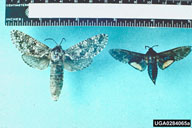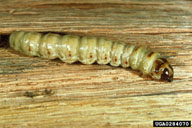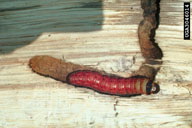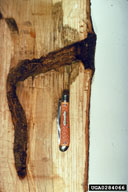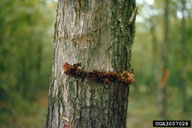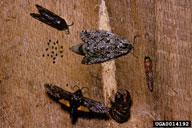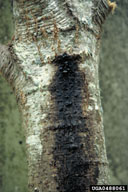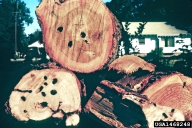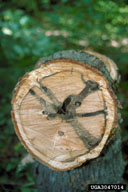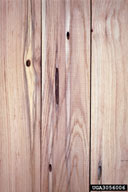Carpenterworm
Prionoxystus robiniae (Peck.) (Lepidoptera: Cossidae)
Orientation to pest
Carpenterworm, Prionoxystus robiniae (Peck.), is a native, wood-boring moth that attacks various hardwoods. Adults emerge between May and August and lay their eggs in large groups (200-1,000) on bark of hosts, often near wounds or objects on the bark such as vines or moss. Young larvae bore into the inner bark and feed there until half grown, at which time they bore into the sapwood and then the heartwood. In southern part of this species' range, immature stages may complete development in a single year, but in northern areas as many as 3 or 4 years may be required. Tunnels to the outside are kept open and enlarged as larvae grow. Tunnels are lined with silk by mature larvae and pupation occurs in the upper end of the tunnel near the exit hole. Pupae, when ready for adult emergence, wriggle to the exit where the adult emerges. The pupal case remains at the entrance of this exit hole. Carpenterworms seldom kill trees, but due to tunneling, infested trees are more likely to break in wind storms, may become more vulnerable to other pests, and the value of affected logs is reduced. No tree size preference has been noted for attack, with trees as small of 5 cm in diameter being infested. However, open grown trees, especially trees in urban landscapes and rural shelterbelts are at greatest risk of attack.
Hosts commonly attacked
In the southern United States, oaks (Quercus), particularly members of the red oak group, are heavily damaged. In the prairies and Rocky Mountains of North America, poplar species (Populus) and green ash (Fraxinus pennsylvanica Marshall) are major hosts. In California, live oak (Quercus agrifolia Née) and introduced elms (Ulmus) are hosts. Other hosts include black locust (Robinia pseudoacacia L.), maple (Acer), and willow (Salix), among others.
Distribution
This borer occurs in widely distributed in the United States and southern Canada.
Images of carpenterworm
Images of Species Number 366
| Figure 1. Adults of the carpenterworm, Prionoxystus robiniae; female (left) and male (right) | ||
| Figure 2. Female carpenterworm, center, in natural position | Figure 3. Larvae of carpenterworm | Figure 4. Larval gallery of carpenterworm (top) and surface injury from lateral gallery in trunk (bottom) |
| Figure 5. Staining and oozing are signs making the point of entrance for carpenterworms | Figure 6. Tunnels of carpenterworms in elm (left) and ash (right) logs at harvest | Figure 7. Defects in milled wood from carpenterworm tunnels and staining | |
Important biological control agents related to this pest species
Little is know about the natural control of carpenterworms. Woodpeckers prey on larvae. Parasitism appears to be minimal.
Web links for information on carpenterworm
- Species Page | E.H. Strickland Entomological Museum, University of Alberta
- Woody Ornamentals Fact Sheet | University of Nebraska-Lincoln
- Fact Sheet | Natural Resources Canada
- BugwoodWiki Article | wiki.bugwood.org
Articles
- McKnight, M. E. and S. Tunnock. 1973. The borer problem in green ash in North Dakota shelterbelts. Shelterbelt Laboratory, Rocky Mountain Forest & Range Experiment Station, Forest Service, USDA, Bottineau, North Dakota, USA. North Dakota Farm Research 30(5): 8-14.
- Solomon, J. D. and C. J. Hay. 1974. Annotated bibliography of the carpenterworm, Prionoxystus robiniae. USDA Forest Service General Technical Report SO-4, Southern Forest Experiment Station, 13 pp.
- Forschler, B. T. and G. L. Nordin, G. L. 1998. Suppression of carpenterworm, Prionoxystus robiniae (Lepidoptera: Cossidae), with the entomophagous nematodes, Steinernema feltiae and S. bibionis. Journal of the Kansas Entomological Society 61: 396-400.
